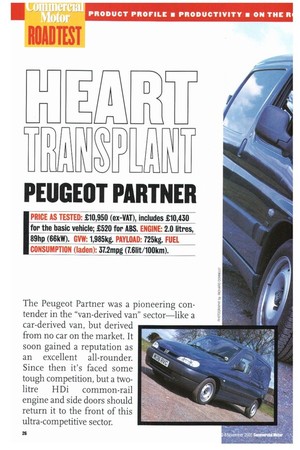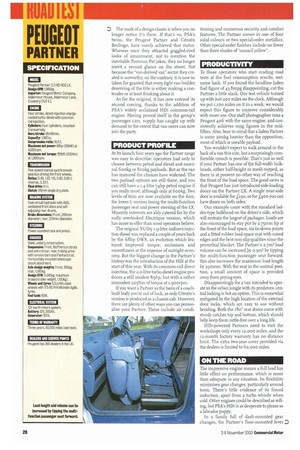PEUGEOT PARTNER
Page 28

Page 30

Page 32

If you've noticed an error in this article please click here to report it so we can fix it.
[PRICE AS TESTED: £10,950 (ex-VAT), includes £10,430 for the basic vehicle; £520 for ABS. ENGINE: 2.0 litres, 89hp (66kW). GVW: 1,985kg. PAYLOAD: 725kg. FUEL CONSUMPTION (laden): 37.2mpg (7.61it/100km). D The mark of a design classic is when you no longer notice it's there. If that's so, PSA's twins, the Peugeot Partner and Citroen Berlingo, have surely achieved that status. Whereas once they attracted goggled-eyed looks of amazement, not to mention the inevitable Postman Pat jokes, they no longer merit a second glance on the street. Not because the "van-derived van" sector they created is unworthy; on the contrary, it is now so taken for granted that every light van builder deserving of the title is either making a contender or at least thinking about it.
As for the original, it has now entered its second coming, thanks to the addition of PSA's widely acclaimed HDi common-rail engine. Having proved itself in the group's passenger cars, supply has caught up with demand to the extent that van users can now join the party.
PRODUCT PROFILE
At its launch four years ago the Partner range was easy to describe: operators had only to choose between petrol and diesel and nominal Gookg or 800kg payloads. But as the van has matured the choices have widened. The two payload options are still there, and you can still have a 1.4-litre 74hp petrol engine if you really must, although only at Gookg. Two levels of trim are now available on the Goo, the lower L version losing the multi-function passenger seat and power steering of the LX. Minority interests are ably catered for by the sadly overlooked EIectrique version. which has more to offer than most operators believe.
The original XU D9 i.9-litre indirect-injection diesel was replaced a couple of years back by the 68hp DW8, an evolution which featured improved torque, emissions and smoothness at the expense of outright economy. But the biggest change in the Partner's history was the introduction of the HDi at the start of this year. With its common-rail direct injection, the 2.o-litre turbo-diesel engine produces a still modest 89hp, but with a rather immodest 2o5Nm of torque at 1.9oorpm.
If you want a Partner as the basis of a coachbuilt body you're out of luck, as only Citroen's version is produced as a chassis-cab. However, there are plenty of other ways you can personalise your Partner. These include air condi
tioning and numerous security and comfort features. The Partner comes in one of four solid colours or two special-order metallics. Other special-order finishes include no fewer than three shades of "council yellow".
PRODUCTIVITY
To those operators who start reading road tests at the fuel consumption results, welcome back. If you found the headline laden fuel figure of 43.8mpg disappointing, cut the Partner a little slack. Our test vehicle turned up with just zoo miles on the clock. Although we put 'Jo° miles on it in a week, we would expect this figure to improve considerably with more use. Our staff photographer runs a Peugeot 406 with the same engine, and consistently achieves mpg figures in the midfifties. Also, bear in mind that a laden Partner is some zookg heavier than the opposition, most of which is useable payload.
You wouldn't expect to walk around in the back of a van this size, but a surprisingly comfortable crouch is possible. That's just as well if your Partner has one of the full-width bulkheads, either half-height or mesh-topped, as there is at present no other way of reaching the front of the load space. The good news is that Peugeot has just introduced side-loading doors on the Partner LX. A single near-side door is available for £230, or for £400 you can have doors on both sides.
Our example came with the standard ladder-type bulkhead on the driver's side, which will restrain the largest of packages. Loads are also encouraged to stay put by a 75mm lip at the front of the load space, six tie-down points and a fitted rubber load-space mat with raised edges and the best non-slip qualities since the proverbial blanket. The Partner's 2.7m3 load volume can be increased J:iy o.3m3 by tipping the multi-function passenger seat forward: this also increases the maximum load length by omm. With the seat in the normal position, a small amount of space is provided away from prying eyes.
Disappointingly for a van intended to operate in the urban jungle with its predators, central locking is but an option. This is somewhat mitigated by the high location of the external door locks, which are easy to use without bending. Both the iflo° rear doors come with sturdy catches top and bottom, which should help keep them rattle-free over a long life.
HDi-powered Partners need to visit the workshops only every 12,000 miles, and the iz-month factory warranty has no distance limit. The extra two-year cover provided via the dealers is limited to Go,000 miles.
ON THE ROAD
The impressive engine means a full load has little effect on performance, which is more than adequate in any situation. Its flexibility minimises gear changes, particularly around town. There's little evidence of its forced induction, apart from a turbo whistle when cold. Other engines could be described as willing, but PSA's HDi is as desperate to please as a labrador puppy.
In a family full of dash-mounted gear changes, the Partner's floor-mounted lever stands out like a quaint relic of another age— but it works well enough, although the clutch bites a little too close to the top of its travel for comfort.
In typical French fashion the ride is extremely supple and comfortable, with only a slight penalty in terms of steering sharpness. Power steering is standard on the LX, and is well matched to the other control inputs. The handling is more than adequate for the power, with just a small amount of safe understeer. When fully loaded the front end is a touch light, but not enough to be a problem.
The disc/drum brake setup seemed powerful enough, but braking performance was limited by the grip of the Michelin Agilis tyres. The optional ABS fitted to the test van had to work hard even in the dry, when the tyres could often be heard chirping away under heavy braking. The handbrake had no problem on the 33% (E-i n-3) test hill in either direction, although getting away again was a different story. The Partner managed the 25% (I-in-q.) test hill restart with no problem, but the 33% found its point of no return and no amount of gentle dutch input could defeat the laws of physics.
The sturdy A-pillar bases create significant blind spots, but forward visibility is otherwise good. With the cruising speeds of which the Partner is capable, it's best to be aware that the central frame of the rear window creates a blind area big enough to hide a Volvo T5 at 8o paces—you have been warned. Our van came without the optional heated rear window or rear wiper. Given the ease with which the windows get dirty, we'd recommend the £150 outlay as a good investment, especially with fixed penalties about to be increased.
Road and mechanical noise is well isolated from the cockpit at low speeds, while any body boom is effectively damped by the interior trim of anti-drum carpet panels. At higher speeds, however, some tyre roar gets through from the rear. The overall build quality seems very high, let down on poor surfaces only by a single rattle from deep within the driver's door.
CAD COMFORT
Presumably there are still French citizens who habitually wear top hats while driving, and the Partner certainly caters for them. For the rest of us there is rather a lot of wasted overhead space, but in all other respects the Peugeot designers have made effective use of the cab dimensions.
With decent sized multi-compartment bins in both doors, a lockable glove box and numerous other nooks and crannies, your odds and ends will always have a home. The multi-use passenger seat can be sat on, folded down to make a worktop or tilted forward for extra length or hidden storage space.
The cabin is equipped in a business-like manner, with the seats and door panel inserts trimmed in tasteful dark blue and gold cloth. The remainder of the cockpit is dark grey plastic below the waist and light grey flock above.
The Partner demands an upright driving position, made comfortable by the heightadjustable steering column and seat belt mountings and a convenient left foot rest. All controls are conveniently placed, with all functions bar the hazard lights operated from the
column stalks, which have a precise, wellengineered feel. One item of note is the feeble horn, which will be used only once—it's far too embarrassing an experience to repeat.
As tested, the Peugeot's instrument panel houses a speedometer and matching analogue clock with fuel and temperature gauges (see box). A simple but effective RDS radio cassette unit is fitted, close to a useful document dip. Windows are manually operated, as are the remote-control door mirrors. The necessarily huge sun visors feature a ticket holder on the driver's side and a vanity mirror for the passenger.
Having been impressed by so many of the Partner's design features, we were all the more disappointed by the heating and ventilation system. There's no recirculation and no provision for separate heated and fresh air flows. The fan was extremely noisy on its first two speeds; beyond that the noise was drowned by the roar of its own airflow. )ust to make matters worse, the engine was rather slow to warm up.
Although all the glass is tinted, the large screen produces a significant greenhouse effect when the sun shines.
Safety is helped by side-impact door beams and a standard airbag for the driver: a second airbag, complete with deactivation switch, is a £250 option. Security measures include an immobiliser as standard; an alarm, deadlocks and the previously mentioned central locking are included in the £365 security pack.
SUMMARY
The original Partner quickly gained a reputation as an excellent all-round van, reinforced since its launch by improved trim options. The refinements provided by the arrival of the H Di engine further enhance the package.
If the Partner had one glaring deficiency compared with its arch-rival from Renault, the Kangoo, it was the absence of the versatility provided by side-loading doors. With that omission finally rectified, it looks as if the Partner and its Citroen twin will regain the high ground in the battleground of van sales.
III by Colin Bartlett












































































































